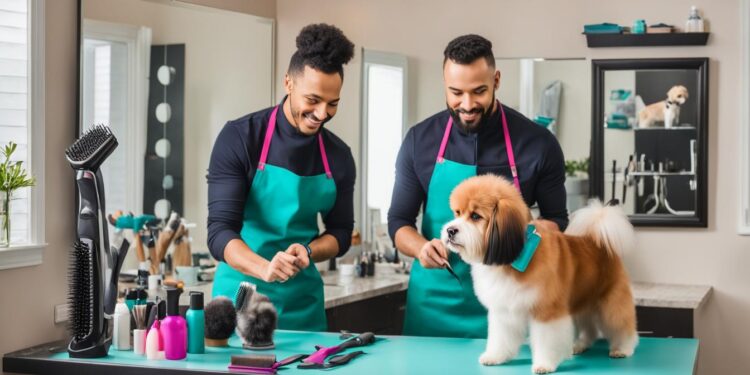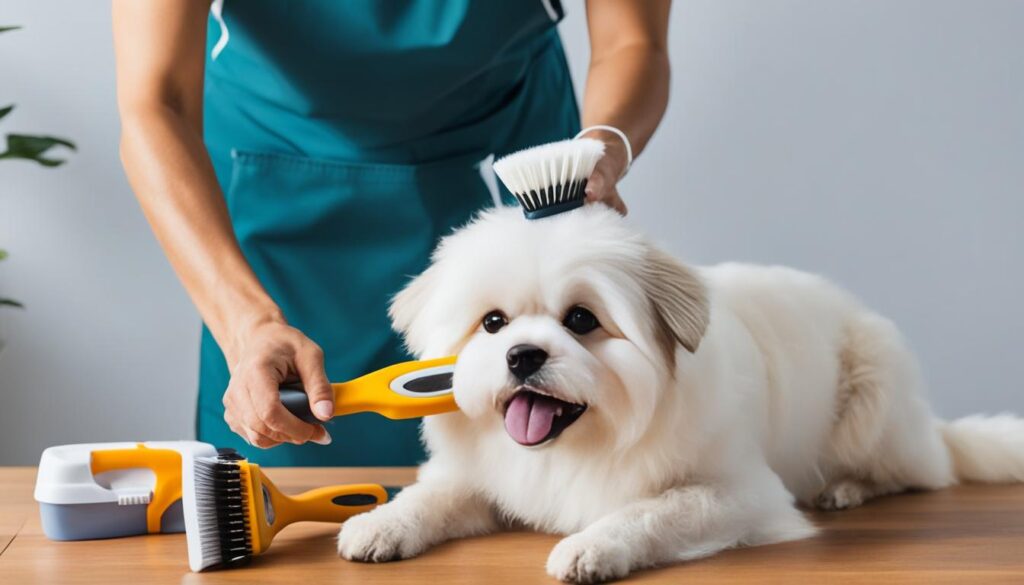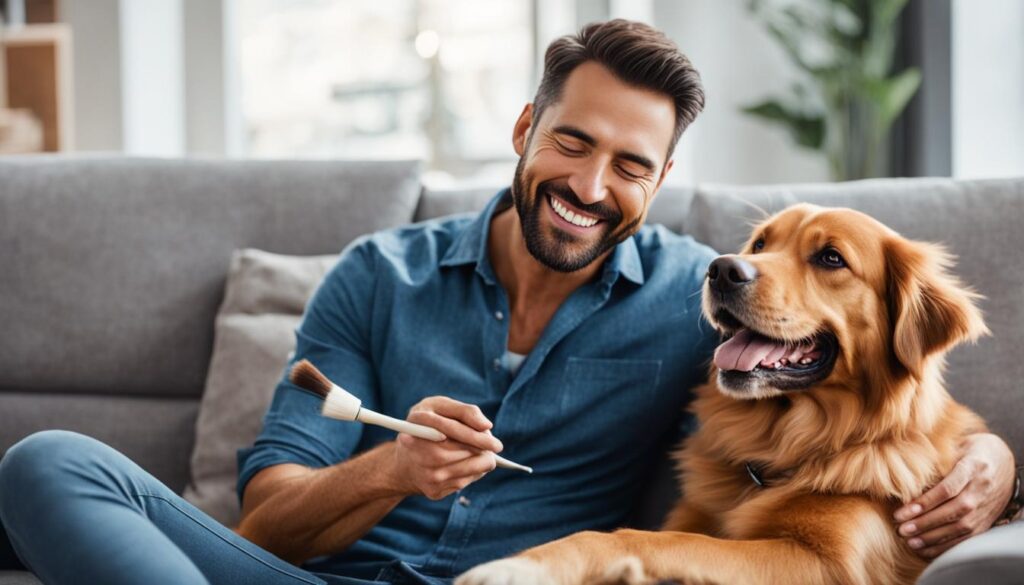Mastering DIY Dog Grooming at Home

DIY dog grooming is a popular choice among pet parents who want to save money and care for their furry friends in the comfort of their own homes. It’s not only cost-effective but also allows you to bond with your dog while maintaining their health and appearance. In this article, we’ll guide you through the essential steps of DIY dog grooming, providing you with the knowledge and tools you need to become a pro at home grooming.
With our comprehensive guide and the right tools, you can turn grooming into a rewarding activity for both you and your dog. From preparing the necessary tools to following a step-by-step process, you’ll learn everything you need to know to groom your dog like a professional. So, whether you’re a beginner or have some grooming experience, it’s time to unleash your inner groomer and give your pet the care they deserve.
Stay tuned for the following sections which will cover the essential tools you’ll need for at-home dog grooming, a step-by-step guide to grooming your dog, the rewards of grooming your dog at home, helpful tips for successful grooming, and a conclusion highlighting the importance of responsible pet ownership. Let’s dive into the wonderful world of DIY dog grooming and discover how you can become a pro at home grooming!
Essential Tools for At-Home Dog Grooming
Grooming your dog at home can be a rewarding experience, but it’s important to have the right tools to ensure a successful grooming session. Here are some essential tools you’ll need:
- Dog Clippers: Invest in quality dog clippers, such as the New 380W Electric Dog Clippers Grooming Shears, for a smooth and safe trimming experience. These clippers are designed specifically for dogs and offer precise cutting without causing any discomfort.
- Grooming Scissors: Grooming scissors are essential for more precise cuts around delicate areas such as the face, ears, and paws. Choose a pair of scissors that are sharp and comfortable to hold for precise grooming.
- Dog Shampoo and Conditioner: It’s important to use dog-specific shampoo and conditioner that are formulated with natural ingredients to suit your dog’s coat and skin needs. Look for products that are gentle, moisturizing, and free from harsh chemicals.
- Brush or Comb: Depending on your dog’s coat type, you’ll need an appropriate brush or comb to detangle and smooth their fur. For example, if your dog has long hair, a slicker brush can help remove tangles and mats, while a bristle brush is suitable for short-haired dogs.
- Nail Clippers: Proper nail care is crucial for your dog’s health and comfort. Make sure you have nail clippers designed for dogs on hand to trim their nails safely. It’s important to learn how to trim your dog’s nails properly to avoid causing any pain or injury.
Having these essential tools in your grooming kit will help you achieve professional-level results and keep your dog looking their best.
Step-by-Step Guide: How to Groom Your Dog at Home
Grooming your dog at home involves a step-by-step process that ensures their cleanliness, comfort, and overall well-being. By following these instructions, you’ll be able to give your furry friend the care they deserve in the comfort of your own home. Let’s get started!
Preparation: Creating a Calming Environment
Before you begin the grooming process, it’s important to create a calming environment for your dog. Find a quiet and familiar space where your dog feels relaxed. Play soft music or provide background noise to help alleviate any anxiety. Before introducing any grooming tools, allow your dog to become acquainted with them by letting them sniff and investigate, which can help reduce stress and make the grooming experience more positive.
Brushing: Removing Dirt, Debris, and Tangles
Start by thoroughly brushing your dog’s coat to remove any loose hair, dirt, debris, and tangles. Use a brush or comb suitable for your dog’s coat type, such as a slicker brush for longer-haired breeds or a bristle brush for shorter coats. Brush in the direction of hair growth, being gentle and patient to avoid causing discomfort to your dog.
Bathing: Keeping Your Dog’s Coat Clean
Once your dog’s coat is free of tangles, it’s time for a bath. Fill a bathtub or basin with lukewarm water and wet your dog’s coat thoroughly. Use a dog-specific shampoo that suits your dog’s skin and coat needs, lathering it gently. Be sure to rinse thoroughly to remove all traces of shampoo.
Note: Never use human shampoo on your dog, as it can be too harsh and irritate their skin.
Drying: Ensuring Comfort and Preventing Infections
After bathing, dry your dog using a towel or a specialized pet dryer. If using a hairdryer, ensure it is on the lowest heat setting and held at a safe distance from your dog’s skin to prevent burns. The 2800W Professional Dog Grooming Hairdryer Blower is an excellent option for efficient and safe drying.
Trimming and Clipping: Keeping Your Dog’s Coat Neat
When it comes to trimming and clipping your dog’s coat, use clippers and scissors that are specifically designed for pets. Work with your dog’s coat in small sections, focusing on areas that tend to accumulate hair, such as the face, ears, paws, and tail. Remember to keep the clippers cool and lubricated to avoid discomfort or potential skin injuries for your dog. The New 380W Electric Dog Clippers Grooming Shears are a reliable choice for safe and precise trimming.
Nail Trimming: Maintaining Healthy Paws
Trimming your dog’s nails is an essential part of grooming. Use dog-specific nail clippers and avoid cutting too close to the quick, which can cause bleeding and discomfort. If your dog has dark nails, be extra cautious. Regular nail trimming prevents overgrowth, reduces the risk of injury, and maintains proper posture and foot health.

| Grooming Step | Key Points |
|---|---|
| Preparation | – Create a calming environment – Introduce grooming tools gradually |
| Brushing | – Remove dirt, debris, and tangles – Use an appropriate brush or comb |
| Bathing | – Use lukewarm water – Use dog-specific shampoo – Thoroughly rinse |
| Drying | – Use a towel or pet dryer – Be cautious with heat |
| Trimming and Clipping | – Work in small sections – Keep clippers cool and lubricated |
| Nail Trimming | – Use dog-specific nail clippers – Avoid cutting the quick |
The Rewards of Grooming Your Dog at Home
Grooming your dog at home can be a truly rewarding experience for both you and your furry companion. Not only does it help maintain their health and hygiene, but it also strengthens the bond between you and your dog. By taking the time to groom your dog yourself, you have the opportunity to spend quality time together and build trust. Your dog will appreciate the personal attention and care you provide during the grooming process.
Regular grooming sessions at home allow you to contribute to your dog’s overall well-being. From brushing their coat to trimming their nails, you can ensure they look and feel their best. Maintaining their health and hygiene is not only important for their physical well-being but also for their mental and emotional health.
Grooming your dog at home offers a unique bonding experience. As you work through the grooming routine, you have the chance to strengthen your relationship and deepen your connection. Your dog will come to see grooming as a positive and enjoyable activity, associating it with love and care.
When grooming your dog at home, it is essential to tailor the routine to their individual needs. Consider their breed, coat type, and any specific grooming requirements. By customizing the process, you ensure that your dog feels comfortable and receives the care they deserve.

Remember to approach grooming with love, patience, and a positive attitude. Use this time to bond with your dog, and reward their good behavior throughout the grooming process. Your dedication to their well-being and the special moments you share will foster a stronger and more meaningful bond between you and your furry friend.
Tips for Successful Dog Grooming at Home
To make your dog grooming experience at home successful, it’s important to follow some helpful tips. Creating a calming environment, gradually introducing grooming tools, and tailoring the grooming routine to your dog’s needs are key elements for a stress-free grooming session.
Creating a Calming Environment
One of the first steps in successful dog grooming at home is to create a calming environment. Dogs can be sensitive to unfamiliar sounds and surroundings, so it’s essential to provide them with a familiar and comfortable space. Play soft, soothing music or use white noise to create a calm atmosphere that will help your dog relax during the grooming process. Additionally, consider using Adaptil diffusers or sprays, which release comforting pheromones to further ease your dog’s anxiety.
Gradual Introduction to Grooming Tools
Just like humans, dogs may feel apprehensive about new experiences. To reduce anxiety, introduce grooming tools gradually. Start by allowing your dog to sniff and inspect the tools while offering treats as positive reinforcement. Associate the clippers, hairdryer, and other grooming tools with positive experiences. For example, turn on the hairdryer without blowing it towards your dog and reward them with treats to create a positive association. This gradual exposure will help your dog become more comfortable with the tools and alleviate their grooming-related fears.
Tailoring Grooming Routine to Your Dog’s Needs
Every dog is unique, and their grooming routine should be tailored to their specific needs. Consider their breed, coat type, and individual preferences when establishing a grooming routine. Some dogs may require daily brushing to prevent matting, while others may only need monthly baths. Use appropriate grooming tools such as slicker brushes, deshedding tools, and dematting combs to cater to your dog’s specific coat type. By customizing the grooming routine to suit your dog, you can ensure a more efficient and enjoyable experience for both of you.
Remember, patience is key when grooming your dog at home. Take breaks if your dog becomes overwhelmed, and always reward good behavior with treats, praise, or playtime. With these tips, you can transform dog grooming from a dreaded chore into a positive and bonding experience for you and your furry friend.
Conclusion
Grooming your dog is an essential part of responsible pet ownership, ensuring their health, well-being, and overall happiness. By following a comprehensive grooming routine and using the right tools, you can achieve professional-level results at home. Whether you choose to groom your dog yourself or seek the help of a professional groomer, the key is to prioritize your dog’s welfare and create a positive grooming experience.
Grooming not only maintains your dog’s appearance but also contributes to their overall health. Regular brushing helps remove loose hair and prevents matting, while bathing keeps their coat clean and free from dirt and parasites. Trimming their nails prevents discomfort and avoids potential injuries. By incorporating grooming into your routine, you can actively contribute to your dog’s well-being.
Grooming sessions also provide valuable bonding time with your dog. It’s an opportunity to build trust, strengthen your relationship, and show them love and care. Take advantage of this one-on-one time to give them extra attention and affection. Make grooming a positive experience by using rewards, praise, and lots of patience. Your dog will appreciate the extra attention and look forward to these special moments together.
FAQ
How often should I groom my dog at home?
The frequency of grooming your dog at home depends on their breed, coat type, and individual needs. As a general guideline, most dogs benefit from regular brushing and bathing every 4-8 weeks. However, it’s important to assess your dog’s coat condition and grooming requirements to determine the optimal grooming schedule.
Can I use regular shampoo to bathe my dog?
No, it is not recommended to use regular shampoo on dogs. Human shampoos can disrupt the natural pH balance of a dog’s skin, leading to dryness, irritation, and potential skin issues. It is best to use dog-specific shampoos that are formulated to suit their specific coat and skin needs.
How do I prevent my dog from feeling anxious during the grooming process?
To help reduce anxiety during the grooming process, create a calming environment by playing soothing music or using familiar sounds. Gradually introduce your dog to the grooming tools, such as clippers and a hairdryer, by allowing them to sniff and explore them before starting the grooming session. Additionally, offering treats and positive reinforcement throughout the process can help alleviate anxiety and make it a more pleasant experience for your dog.
What should I do if my dog gets anxious or agitated during grooming?
If your dog becomes anxious or agitated during grooming, it’s essential to remain calm and patient. Take breaks if needed and offer reassurance to your dog through soothing tones and gentle strokes. If your dog’s anxiety persists or worsens, consider seeking advice from a professional dog trainer or behaviorist for additional support.
How can I trim my dog’s nails safely?
Trimming your dog’s nails should be done carefully to avoid cutting the quick, which can cause bleeding and pain. Use quality nail clippers designed specifically for dogs and familiarize yourself with the proper technique. Take it slow, trim small amounts at a time, and observe your dog’s reactions. If unsure, consult with your veterinarian or a professional groomer for guidance on how to safely trim your dog’s nails.
Can I groom my long-haired dog at home?
Yes, you can groom your long-haired dog at home. However, keep in mind that long-haired dogs often require more frequent grooming to prevent matting and tangles. Regular brushing, using appropriate tools like a dematting comb or slicker brush, can help keep their coat in good condition. It’s also important to be patient and gentle while brushing to avoid causing discomfort or pain to your dog.





